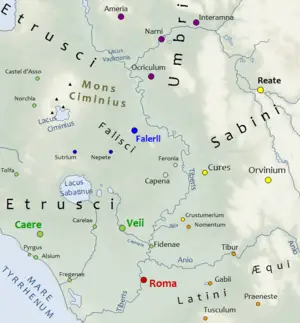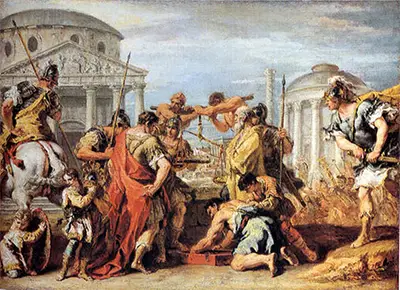Camillus: the 'Second Founder of Rome'
Marcus Furius Camillus was a successful general who saved the Roman Republic from destruction more than once and was hailed as the "Second Founder of Rome." 
He was born in 446 or 445 B.C. in the city of Tusculum, a prominent member of the Latin League. His father was Lucius Furius Medullinus, and he was a tribune. Young Marcus gained his surname, Camillus, from his role as assistant to a priest. Camillus proved a very adept soldier, fighting against the Aequians and Volscians. He was an adept administrator, using his appointment as censor to reform the tax system to provide exemptions for war orphans. 
Named dictator, Camillus led the army in a full-throated struggle against neighboring Veii. After subduing its allies Capena and Falerii, Camillus turned to Veii itself. He triumphed through a combination of strength and stealth. Taking from a captured resident of the city the vital information that the ground underneath the city walls was soft enough to dig under, he sent a large force against the front gates but only as a diversion, as another part of his force tunneled underneath the walls and surprised the defenders from behind. The conquest was thereafter swift. 
Despite this victory, Camillus soon fell out with the citizens of Rome because of his policies afterward. He denied a request for Roman citizens to relocate to Veii because he feared that doing so would not ease the overpopulation of Rome so much as weaken its defense. As well, he celebrated his triumph over Veii so much that his fellow Romans viewed him as comparing himself to the gods and he went back on his promise to offer a tenth of the spoils of the conquest to Apollo. His next turn as army commander was against a resurgent Falerii. Settling in for a siege, Camillus was surprised one day to encounter the sons of nobles whose teacher had offered them as a prize if the Romans would end the siege. A magnanimous Camillus returned to the teacher and his pupils to the city unharmed, and the residents of Falerii were so impressed that they made their peace with Camillus. In return, the commander ordered the city to remain unplundered. When Camillus returned to Rome, he announced what he done at Falerii and reiterated his opposition the movement of some of the population to Veii. His political adversaries charged him with embezzlement and impeached him. Camillus left the city with his wife and son, to live in Ardea. 
In 390 B.C., a group of Gauls led by the Senone chieftain Brennus defeated a Roman army at the Battle of the Allia and then marched on Rome itself. The victorious Gauls sacked the city and then marched on Ardea. Camillus raised an army and fought back, defeating the Gauls. He followed them to Rome and defeated them there as well. The Romans then referred to their savior as the "Second Founder of Rome." He remained dictator at the Senate's request and fought off yet another invasion, by a combined army of Aequi and Volsci. The Senate named Camillus dictator for a fifth time in 367 B.C., to head up the defense of Rome yet again in the face of another invasion of tribes from Gaul. He proved the victory yet again and celebrated by ordering built the Temple of Concord. The elderly Camillus was no match for a plague that blew through Rome in 365 B.C. He was deeply mourned. |
|
Social Studies for Kids
copyright 2002–2024
David White




